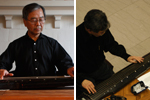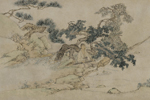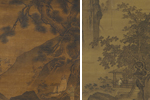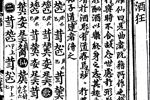
PROGRAM NOTES
Ancient Music for the Chinese Zither
Listen Now
download
Subscribe (itunes)
Subscribe (rss)
help
Program
Ancient Music for the Chinese Zither
Bell Yung, qin
This performance was recorded live at the Freer Gallery of Art on October 27, 2005, in conjunction with the exhibition Virtue and Entertainment: Music in Chinese Art.
| Title | Time |
|---|---|
| Moon over the Pass (Guanshan Yue) Composer Unknown |
0:00-2:05 |
Lamenting the Past (Kaigu Yin) |
2:12-5:37 |
Wine Madness (Jiukuang) |
5:46 -8:46 |
Wild Geese Descending to Sandbar (Pingsha Luoyan) |
8:53-16:35 |
Magpies Cry in the Night (Wuyeti) |
16:44-25:26 |
The podcast is made possible through support from the Thaw Charitable Trust. Audio preservation and editing of this recording were supported by funds from the Smithsonian Women’s Committee.
Listen Now
download
Subscribe (itunes)
Subscribe (rss)
help
Notes
The Instrument
The history of the qin (pronounced “chin”), or guqin (ancient qin), dates back at least two millennia. Its repertoire embodies China’s three major religious-philosophical systems of Confucianism, Taoism, and Buddhism. The first two systems developed originally in China, while the last of these arrived from South Asia via the Silk Road in the first century. While all three systems exerted influence over the history, ideology, and aesthetics of qin music, each also played its role in different aspects of the tradition. For example, Confucianism provided many stories to the qin repertoire that address the hierarchy of the five cardinal social orders, such as loyalty to one’s emperor. Taoism and Buddhism contrast with Confucian ideology by rejecting human society altogether, turning for inspiration instead to the simplicity of nature and to the inner spiritual world of the individual. Some of the most distinguished qin musicians in Chinese history were Buddhist monks, who played this type of zither in the seclusion of their temples and passed on their art to their younger disciples.
The instrument has seven strings made of twisted silk and mounted on a hollow, lacquered wooden box. Thirteen markers run along the outer edge. Since the qin has no frets or bridges, the performer uses the right hand to pluck the strings while the left hand slides along and stops them. In its current form, the qin has been documented in China for about two thousand years. It is associated with scholar-officials, as depicted in works of art in the Freer Gallery. It is played mainly for one’s own enjoyment or for a small group of friends, often amidst the grandeur of nature. The instrument Bell Yung plays dates from 1640 and has its name, “Pines from Ten Thousand Gullies,” carved on the reverse.
The Music
Moon over the Pass (Guanshan Yue)
This piece is sometimes sung to a poem of the same title by the poet Li Bo (701–762). The first stanza of the poem reads:
The bright moon rises out of the mountain peaks of Tianshan;
It roams among the vast and hazy sea of clouds.
A strong wind travelled for ten thousand miles from the West,
Arriving at the frontier fort of Jade Pass.
The composer is unknown. The earliest extant notation is in the 1931 collection Mei’an Qinpu, which is the version played on this podcast. Bell Yung learned this piece from Tsar Teh-yun (1905–2007).
See the slideshow for Chinese paintings that feature the moon.
Lamenting the Past (Kaigu Yin)
This anonymous piece is sometimes sung to a poem of the same title. Three lines of it capture the essence of the composition:
Momentous events were long past, where are the heroes now?
Yet the moon continues to rise night after night.
The flowers bloom in the splendor of my hometown—who is there to appreciate it?
The earliest known sources for this piece are Gong Guangbiao, who died in 1907, and Yu Weichun, who died in 1913. The earliest extant published notation is found in the collection Yinyinshi Qinpu (1960), which is the version heard here. Bell Yung learned the piece from Tsar Teh-yun.
Wine Madness (Jiukuang)
Zhu Quan (1378–1448), the editor of a collection of notation in 1425, wrote, “This piece is composed by Yuan Ji, who lamented that the Tao was lost, and that he lived in the wrong time. He therefore abandoned the concerns of this world, but relied on wine to attain his goal in life. . . .” The music is attributed to Yuan Ji, a composer who was active in the third century CE. The earliest extant notation is in the collection Shenqi Mipu (1425), which is the version heard here. Bell Yung learned this piece from Yao Bingyan (1920–1982).
Wild Geese Descending to Sandbar (Pingsha Luoyan)
This composition embodies the Taoist ideals of simplicity and the quietness of nature. It is attributed to the composer Prince Zhu Quan (died 1448). The earliest extant notation is in the collection Guyin Zhengzong (1643). The version heard here is found in the collection Jiao’an Qinpu (1868). Bell Yung learned the piece from Tsar Teh-yun.
See the slideshow for a Chinese painting depicting wild geese descending upon a sandbar.
Magpies Cry in the Night (Wuyeti)
This composition embodies Confucian social hierarchy and power structure. Zhu Quan (1378–1448), the editor of a 1425 collection of notation, wrote (condensed here),
This composition was attributed to a prominent writer Liu Yiqing, a royal prince of the Song Dynasty. In the year 440, Liu Yikang, another royal prince, was banished by Emperor Wen to a region where, at the time, Liu Yiqing was the governor. When the two cousins met, they wept. Hearing about it, Emperor Wen was displeased and ordered Liu Yiqing to leave his post and return to his hometown. There, the entire family was in great fear of what might befall them next. One night, Liu’s wife heard magpies crying. She said to him that it was an auspicious sign that indicated he would be pardoned. Later that year, he indeed was and afterwards composed this piece.
While the composer of this piece is unknown, it has been attributed to Liu Yiqing (403–444). The earliest extant notation is in the collection Shenqi Mipu (1425), which is the version heard here. Bell Yung learned this piece from Yao Bingyan.
See a Chinese painting with magpies in the slideshow accompanying this podcast.
Listen Now
download
Subscribe (itunes)
Subscribe (rss)
help
Performer
Bell Yung is emeritus professor of music at the University of Pittsburgh. He specializes in the history and theory of Chinese music, Cantonese opera, Cantonese narrative songs, music of the qin, Chinese ritual music, and American composer and musicologist Charles Seeger. He also taught at the University of Hong Kong, the Chinese University of Hong Kong, the University of California at Davis, and Cornell University. From 2002 to 2006 he served as director of the Asian Studies Center at the University of Pittsburgh.
He received his first PhD, in physics, from the Massachusetts Institute of Technology in 1970. Six years later he received his second doctorate, in music, from Harvard. In 2012 he was awarded an honorary doctorate by the Chinese University of Hong Kong. A recipient of numerous honors and grants, including Guggenheim, Mellon, Fulbright, and National Endowment for the Humanities honors, Dr. Yung is the author, editor, and co-editor of ten books and more than fifty scholarly articles. He has also edited museum catalogues, a DVD, and several CDs. He has performed qin at Emory University, Bowdoin College, and at the universities of Michigan, Pittsburgh, Hong Kong, and Haifa. In May 2012 he joined Andrew Appel of the Four Nations Baroque Ensemble in a private concert of qin and clavichord in New York City.
Listen Now
download
Subscribe (itunes)
Subscribe (rss)
help
Related Images

Bell Yung plays a Chinese qin that was made in 1640 during the Ming dynasty. The Freer Gallery collection includes two qin from the same period: one inscribed with the name “Spring Breeze,” and an even older instrument from the Tang or Northern Song dynasties (7th-12th centuries), which was evocatively called "Dragon's Moan." (Photos courtesy of Bell Yung)

According to Chinese tradition, the qin is performed mainly for one’s own pleasure or for a small group of friends while contemplating the grandeur of nature. In this Ming dynasty painting, a lone scholar plays a qin beneath a pine tree. In Chinese art, pine trees often evoke longevity, steadfastness, and self-discipline, qualities that were prized by Confucian scholars. Bell Yung’s qin is named “Pines from Ten Thousand Gullies.”
Detail, Playing the Zither Beneath a Pine Tree, by Qiu Ying (ca. 1494–1552); China, Ming dynasty, late 16th–early 17th century; ink and color on paper; Purchase, F1953.84

Moon over the Pass is sometimes performed while singing an eighth-century poem that begins, “The bright moon rises out of the mountain peaks of Tianshan/It roams among the vast and hazy sea of clouds. . . .” These Chinese paintings show a philosopher gazing at the moon under wind-swept pines and a moonlit pavilion in the mountains.
LEFT: Gazing at the Moon under Wind-swept Pines, by Ma Yuan (act. late 12th–early 13th century); China, Ming dynasty, mid-15th century; hanging scroll, ink and color on silk; Gift of Charles Lang Freer, F1918.4
RIGHT: Moonlit Pavilion in the Mountains, by Ma Yuan (act. late 12th–early 13th century); China, Ming dynasty, ca. 1500; ink and color on silk; Gift of Charles Lang Freer, F1907.140

Wine Madness, the third piece on this podcast, survives in a tablature notation that shows how to pluck and stop the strings rather than what note to produce. It comes from a collection assembled in 1425. The columns are read from top to bottom and from right to left. The song’s title is in the first column at right, followed by the editor’s preface in which he relates the composer’s complaint that the world has lost the Tao (the Way).

Bell Yung shows different methods of stopping a string to produce a range of musical effects. (Images courtesy of Bell Yung.)

Wild Geese Descending to a Sandbar takes its title from a work in Eight Views of the Xiao and Xiang Rivers, an album of famous landscapes in modern-day Hunan province. The Eight Views gained renown within Chinese literary and artistic circles during the Song dynasty (960-1368) and later became well known in Korea.
Alighting Wild Geese on Sandbar, by Sheng Maoye (act. ca. 1600–40); from the album Eight Views of the Xiao and Xiang Rivers; China, Ming dynasty, 1621; ink and color on paper; Gift of Arthur M. Sackler, S1987.270.2

The last musical piece has been attributed to Liu Yiqing, a composer whose wife believed the cries of a magpie foretold good news. In Chinese art, these relatives of American jays and crows are considered magical. They serve as envoys of shrine deities that protect households and communities. According to one legend, magpies knit a bridge across the Milky Way each year so star-crossed lovers (a human and an immortal) can meet.
Detail, Magpies in a Pine Tree, Ducks and Hollyhocks; China, Ming or Qing dynasty, 17th–19th century; ink and colors on silk; Purchase–Smithsonian Collections Acquisition Program, and partial gift of Richard G. Pritzlaff, S1991.138
Listen Now
download
Subscribe (itunes)
Subscribe (rss)
help
The Credits
Podcast, texts, and the slideshow were coordinated by Michael Wilpers, manager of public programs. This podcast is made possible through support from the Thaw Charitable Trust. Audio preservation and editing of this recording were supported by funds from the Smithsonian Women’s Committee.
Thanks to Joanna Pecore for organizing and supervising the original performance, Andy Finch and SuMo Productions for audio recording and editing, Nancy Eickel for text editing, Torie Castiello Ketcham for web design, and especially Bell Yung for granting permission for this podcast of his performance at the Freer Gallery.
Podcast Series
Concerts
Storytelling
Lectures
Subscribe to this Series
 RSS
RSS iTunes
iTunes
About Podcasts
About podcasting and how to get started
![]() Tell us what you think
Tell us what you think
Radio Asia
Explore music from all across Asia with Radio Asia, a stream of complete tracks from the collections of Smithsonian Global Sound
Most Recent Podcasts
Musicians from Marlboro IMusic of Toru Takemitsu and Tan Dun: Ralph Van Raat, piano
The Legacy of Yatsuhashi
The Traveler’s Ear: Scenes from Music
Western Music in Meiji Japan: Gilles Vonsattel, piano
Western Music in Meiji Japan
The Art of Afghan Music
Painting with Music: Bell Yung, qin
Sounds from Arabia
Tarek Yamani Trio